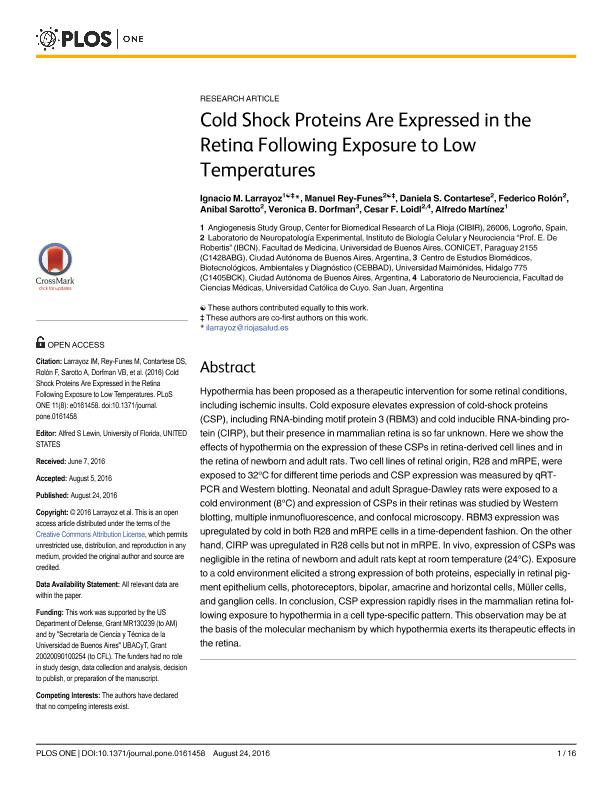Mostrar el registro sencillo del ítem
dc.contributor.author
Larráyoz, Ignacio M.

dc.contributor.author
Rey Funes, Manuel

dc.contributor.author
Contartese, Daniela Soledad

dc.contributor.author
Rolón, Federico
dc.contributor.author
Sarotto, Anibal
dc.contributor.author
Dorfman, Verónica Berta

dc.contributor.author
Loidl, Cesar Fabian

dc.contributor.author
Martínez, Alfredo
dc.date.available
2018-05-29T20:08:10Z
dc.date.issued
2016-08
dc.identifier.citation
Larráyoz, Ignacio M.; Rey Funes, Manuel; Contartese, Daniela Soledad; Rolón, Federico; Sarotto, Anibal; et al.; Cold Shock Proteins Are Expressed in the Retina Following Exposure to Low Temperatures; Public Library of Science; Plos One; 11; 8; 8-2016; 1-16; e0161458
dc.identifier.issn
1932-6203
dc.identifier.uri
http://hdl.handle.net/11336/46512
dc.description.abstract
Hypothermia has been proposed as a therapeutic intervention for some retinal conditions, including ischemic insults. Cold exposure elevates expression of cold-shock proteins (CSP), including RNA-binding motif protein 3 (RBM3) and cold inducible RNA-binding protein (CIRP), but their presence in mammalian retina is so far unknown. Here we show the effects of hypothermia on the expression of these CSPs in retina-derived cell lines and in the retina of newborn and adult rats. Two cell lines of retinal origin, R28 and mRPE, were exposed to 32°C for different time periods and CSP expression was measured by qRT-PCR and Western blotting. Neonatal and adult Sprague-Dawley rats were exposed to a cold environment (8°C) and expression of CSPs in their retinas was studied by Western blotting, multiple inmunofluorescence, and confocal microscopy. RBM3 expression was upregulated by cold in both R28 and mRPE cells in a time-dependent fashion. On the other hand, CIRP was upregulated in R28 cells but not in mRPE. In vivo, expression of CSPs was negligible in the retina of newborn and adult rats kept at room temperature (24°C). Exposure to a cold environment elicited a strong expression of both proteins, especially in retinal pigment epithelium cells, photoreceptors, bipolar, amacrine and horizontal cells, Müller cells, and ganglion cells. In conclusion, CSP expression rapidly rises in the mammalian retina following exposure to hypothermia in a cell type-specific pattern. This observation may be at the basis of the molecular mechanism by which hypothermia exerts its therapeutic effects in the retina.
dc.format
application/pdf
dc.language.iso
eng
dc.publisher
Public Library of Science

dc.rights
info:eu-repo/semantics/openAccess
dc.rights.uri
https://creativecommons.org/licenses/by-nc-sa/2.5/ar/
dc.subject
Cold Shock Proteins
dc.subject
Hypothermia
dc.subject
Retina
dc.subject
Cold Shock Proteins
dc.subject.classification
Neurociencias

dc.subject.classification
Medicina Básica

dc.subject.classification
CIENCIAS MÉDICAS Y DE LA SALUD

dc.title
Cold Shock Proteins Are Expressed in the Retina Following Exposure to Low Temperatures
dc.type
info:eu-repo/semantics/article
dc.type
info:ar-repo/semantics/artículo
dc.type
info:eu-repo/semantics/publishedVersion
dc.date.updated
2018-05-29T14:52:53Z
dc.journal.volume
11
dc.journal.number
8
dc.journal.pagination
1-16; e0161458
dc.journal.pais
Estados Unidos

dc.journal.ciudad
San Francisco
dc.description.fil
Fil: Larráyoz, Ignacio M.. Centro de Investigación Biomédica de La Rioja; España
dc.description.fil
Fil: Rey Funes, Manuel. Universidad de Buenos Aires. Facultad de Medicina. Instituto de Biología Celular y Neurociencias; Argentina
dc.description.fil
Fil: Contartese, Daniela Soledad. Universidad de Buenos Aires. Facultad de Medicina. Instituto de Biología Celular y Neurociencias; Argentina
dc.description.fil
Fil: Rolón, Federico. Universidad de Buenos Aires. Facultad de Medicina. Instituto de Biología Celular y Neurociencias; Argentina
dc.description.fil
Fil: Sarotto, Anibal. Universidad de Buenos Aires. Facultad de Medicina. Instituto de Biología Celular y Neurociencias; Argentina
dc.description.fil
Fil: Dorfman, Verónica Berta. Universidad Maimónides. Área de Investigaciones Biomédicas y Biotecnológicas. Centro de Estudios Biomédicos, Biotecnológicos, Ambientales y de Diagnóstico; Argentina. Consejo Nacional de Investigaciones Científicas y Técnicas; Argentina
dc.description.fil
Fil: Loidl, Cesar Fabian. Universidad de Buenos Aires. Facultad de Medicina. Instituto de Biología Celular y Neurociencias; Argentina. Universidad Católica de Cuyo - Sede San Juan. Facultad de Ciencias Médicas; Argentina. Consejo Nacional de Investigaciones Científicas y Técnicas; Argentina
dc.description.fil
Fil: Martínez, Alfredo. Centro de Investigación Biomédica de La Rioja; España
dc.journal.title
Plos One

dc.relation.alternativeid
info:eu-repo/semantics/altIdentifier/doi/https://dx.doi.org/10.1371/journal.pone.0161458
dc.relation.alternativeid
info:eu-repo/semantics/altIdentifier/url/http://journals.plos.org/plosone/article?id=10.1371/journal.pone.0161458
Archivos asociados
